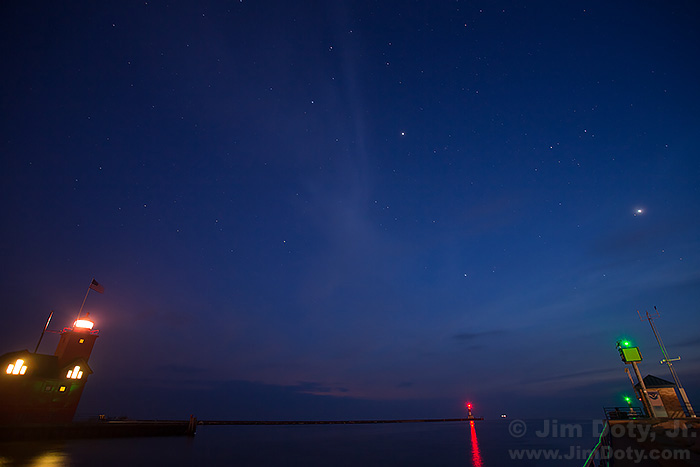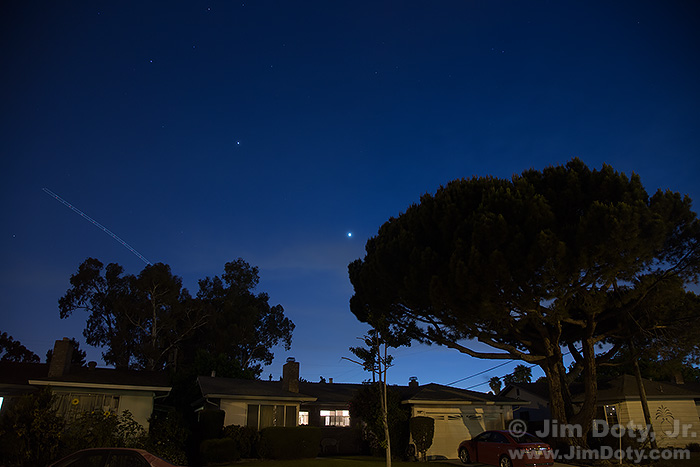Tonight is the night for the “Star of Bethlehem” conjunction of Venus and Jupiter. They will come within 1/3 of a degree of each other in the western sky.
In mid-May it took a wide angle lens to show both of them in the night sky along with the landscape. Since then Jupiter has moved steadily closer. Two nights ago I could hide both of them behind the tip of my thumb at arm’s length. Tonight they will be at their closest.
In 3-2 BC Venus and Jupiter did their night sky dance over a period of several months, ending up 1/100 of a degree apart near the star Regulus. To the ancients that added up to royalty. That is why some scholars think the 3-2 conjunction sent the wise men/magi on their journey to Bethlehem. Tonights conjunction will again be in the area of Regulus. That is why some people are calling tonight’s event the Star of Bethlehem conjunction.
Don’t miss is it. Tonight after sunset look west as the sky gets darker. Here’s hoping for clear skies. Unfortunately it looks pretty cloudy here in central Ohio.
What if you miss the show June 30? All is not lost. Venus and Jupiter will begin to separate gradually but still be close together in the evening sky, making a very pretty sight. Go out and look west.
Want to take a picture? Put your camera on a tripod and focus your lens manually on infinity. Set the ISO to 400 or 800 and the aperture to f/4. Start when the sky is a medium dark blue but not too dark. Try shutter speeds of 4 seconds, 8 seconds, 15 seconds, and 30 seconds. Let the sky get darker (5-10 minutes later) and repeat the whole series pf shutter speeds again. Wait another 5-10 minutes and repeat the series again. Keep this up until the sky is totally dark. Depending on personal tastes some people like more blue in the sky and other like little or none. Include some of the surroundings in your photo so you have more than just white dots in the sky. For this kind of photography a normal to wide angle lens works best. If you use longer focal lengths the planets and stars will streak due to the movement of the earth while the shutter is open. Earlier in the evening the short shutters speeds will look better. Later on, the long shutter speeds will be best. The exposure will also be influenced by sky glow from city lights.
It is impossible for me to predict the exact sky conditions where you live but the exposures listed above should get you close in most situations. If all the photos look too way too light when using shutter speeds from 4 to 30 seconds. Go to a lower ISO like 200 or 100. If all the photos in a series look way too dark, got to a higher ISO like 1600 or 3200. Experiment!
Photo Data:
Michigan photo. Venus is the brightest object above the green light. Jupiter is higher up toward the upper central part of the photo, and to the right of the cloud in the upper central part of the photo. Canon 5D Mark III. Canon EF17-40mm f/4L USM lens at 17 mm. 30.0 sec, f/4.5, ISO 400.
California photo. Venus is just to the left of the larger tree. Jupiter is farther up and to the left. The lights above the tree at the left are from a plane headed for the San Francisco airport. Given the millions of people who live all around the Bay Area, this photo came out better than I expected. Canon 5D Mark III. Canon EF24-105mm f/4L IS USM lens at 24mm. 15.0 sec, f/5.6, ISO 400.
Links
The Star of Bethlehem conjunction at ABC news.


